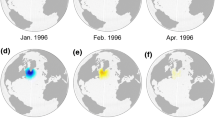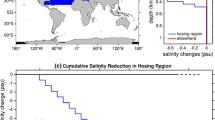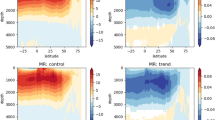Abstract
The response of the Atlantic meridional overturning circulation (AMOC) to an increase of radiative forcing (ramp-up) and a subsequent reversal of radiative forcing (ramp-down) is analyzed for four different global climate models. Due to changes in ocean temperature and hydrological cycle, all models show a weakening of the AMOC during the ramp-up phase. Once the external forcing is reversed, the results become model dependent. For IPSL-CM5A-LR, the AMOC continues its weakening trend for most of the ramp-down experiment. For HadGEM2-ES, the AMOC trend reverses once the external forcing also reverses, without recovering its initial value. For EC-EARTH and MPI-ESM-LR the recovery is anomalously strong yielding an AMOC overshoot. A robust linear dependency can be established between AMOC and density difference between North Atlantic (NA) deep water formation region and South Atlantic (SA). In particular, AMOC evolution is primarily controlled by a meridional salinity contrast between these regions. During the warming scenario, the subtropical Atlantic becomes saltier while the NA experiences a net freshening which favours an AMOC weakening. The different behaviour in the models during the ramp-down is dependent on the response of the ocean at the boundaries of NA and SA. The way in which the positive salinity anomaly stored in the subtropical Atlantic during the ramp-up is subsequently released elsewhere, characterizes the recovery. An out-of-phase response of the salinity transport at \(48^{\circ }\hbox {N}\) and \(34^{\circ }\hbox {S}\) boundaries is able to control the meridional density contrast between NA and SA during the transient experiments. Such a non-synchronized response is mainly controlled by changes in gyre salinity transport rather than by changes in overturning transport, thus suggesting a small role of the salt advection feedback in the evolution of the AMOC.














Similar content being viewed by others
References
Alley RB et al (2003) Abrupt climate change. Science 299:2005–2010
Armour KC, Eisenman I, Blanchard-Wrigglesworth E, McCusker KE (2011) The reversibility of sea ice loss in a state-of-the-art climate model. Geophys Res Lett 38(L16):705
Boucher O et al (2012) Reversibility in an Earth System model in response to CO2 concentration changes. Environ Res Lett 7:024013. doi:10.1088/1748-9326/7/2/024013
Bouttes N, Gregory JM, Lowe JA (2013) The reversibility of sea level rise. J Clim 26:2502–2513
Broecker WS (1997) Thermohaline circulation, the Achilles heel of our climate system: will man-made CO2 upset the current balance? Science 278:1582–1588
Bryan F (1986) High-latitude salinity effects and interhemispheric thermohaline circulation. Nature 323:301–304. doi:10.1038/323301a0
Bryden HL, King BA, McCarthy GD, McDonagh EL (2014) Impact of a 30 % reduction in Atlantic meridional overturning during 2009–2010. Ocean Sci Discuss 11:789–810
Bryden HL, Longworth HR, Cunningham SA (2005) Slowing of the Atlantic meridional overturning circulation at 25°N. Nature 438:655–657
Clark PU, Pisias NG, Stocker TF, Weaver AJ (2002) The role of thermohaline circulation in abrupt climate change. Nature 415:863–869
Collins WJ et al (2011) Development and evaluation of an Earth-system model—HadGEM2. Geosci Model Dev Discuss 4:997–1062. doi:10.5194/gmdd-4-997-2011
de Vries P, Weber SL (2005) The Atlantic freshwater budget as a diagnostic for the existence of a stable shut-down of the meridional overturning circulation. Geophys Res Lett 32(L09):606. doi:10.1029/2004GL021450
Dijkstra HA (2007) Characterization of the multiple equilibria regime in a global ocean model. Tellus A 59:695–705. doi:10.1111/j.1600-0870.2007.00267.x
Dixon KW, Delworth TL, Spelman MJ, Stouffer RJ (1999) The influence of transient surface fluxes on the North Atlantic overturning in a coupled GCM climate change experiment. Geophys Res Lett 26:2749–2752
Drijfhout S, van Oldenborgh GJ, Cimatoribus A (2012) Is a Decline of AMOC causing the warming hole above the North Atlantic in observed and modeled warming patterns? J Clim 25:8373–8379. doi:10.1175/JCLI-D-12-00490.1
Drijfhout SS, Weber SL, Swaluw E (2010) The stability of the MOC as diagnosed from model projections for pre-industrial, present and future climates. Clim Dyn 37:1575–1586. doi:10.1007/s00382-010-0930-z
Dufresne J-L et al (2013) Climate change projections using the IPSL-CM5 Earth System model: from CMIP3 to CMIP5. Clim Dyn 40:2123–2165. doi:10.1007/s00382-012-1636-1
Ganachaud A, Wunsch (2003) Large-scale ocean heat and freshwater transports during the World Ocean Circulation Experiment. J Clim 16:696–705
Garzoli SL, Baringer MO, Dong S, Perez RC, Yao Q (2013) South Atlantic meridional fluxes. Deep-Sea Res I 71:21–32
Giorgetta MA et al (2013) Climate and carbon cycle changes from 1850 to 2100 in MPI-ESM simulations for the coupled model intercomparison project phase 5. J Adv Model Earth Syst 5:572–597. doi:10.1002/jame.20038
Gregory JM et al (2005) A model intercomparison of changes in the Atlantic thermohaline circulation in response to increasing atmospheric CO 2 concentration. Geophys Res Lett 32:L12 703–L12 707
Hawkins E, Smith RS, Allison LC, Gregory JM, Woollings TJ, Pohlmann H, de Cuevas B (2011) Bistability of the Atlantic overturning circulation in a global climate model and links to ocean freshwater transport. Geophys Res Lett 38(L10):605. doi:10.1029/2011GL047208
Hofmann M, Rahmstorf S (2009) On the stability of the Atlantic meridional overturning circulation. Proc Natl Acad Sci USA 106(20):584–589. doi:10.1073/pnas.0909146106
Hu A, Meehl GA, Han W, Yin J (2011) Effect of the potential melting of the Greenland Ice sheet on the meridional overturning circulation and global climate in the future. Deep Sea Res 58:1914–1926. doi:10.1016/j.dsr2.2010.10.069
Huisman SE, den Toom M, Dijkstra H a, Drijfhout S (2010) An indicator of the multiple equilibria regime of the Atlantic meridional overturning circulation. J Phys Oceanogr 40:551–567. doi:10.1175/2009JPO4215.1
IPCC (2013) Summary for policymakers. In: Climate change 2013: the physical science basis. Contribution of working group I to the Fifth assessment report on the intergovernmental panel on climate change, Cambridge University Press, Cambridge, New York
Jackson LC, Schaller N, Smith RS, Palmer MD, Vellinga M (2014) Response of the Atlantic meridional overturning circulation to a reversal of greenhouse gas increases. Clim Dyn 42:3323–3336. doi:10.1007/s00382-013-1842-5
Johns WE et al (2011) Continuous, array-based estimates of Atlantic Ocean heat transport at 26.5°N. J Clim 24:2429–2449
Kanzow T et al (2010) Seasonal variability of the Atlantic meridional overturning circulation at 26.5°N. J Clim 23:5678–5698. doi: 10.1175/2010JCLI3389.1
Lenton TM (2011) Early warning of climate tipping points. Nat Clim Change 1:201–209. doi:10.1038/nclimate1143
Liu W, Liu Z (2013) A diagnostic indicator of the stability of the Atlantic meridional overturning circulation in CCSM3. J Clim 26:1926–1938. doi:10.1175/JCLI-D-11-00681.1
Manabe S, Stouffer RJ (1988) Two stable equlibria of a coupled ocean-atmosphere model. J Clim 1:841–866. doi:10.1175/1520-0442(1988)001<0841:TSEOAC>2.0.C;2
Manabe S, Stouffer RJ (1993) Century-scale effects of increased atmospheric CO2 on the ocean-atmosphere system. Nature 364:215–218
Manabe S, Stouffer RJ (1995) Simulation of abrupt changes induced by freshwater input to the North Atlantic. Nature 378:165–167
Meinshausen M et al (2011) The RCP greenhouse gas concentrations and their extensions from 1765 to 2300. Clim Change 109:213–241. doi:10.1007/s10584-011-0156-z
Nakashiki N, Kim D-H, Bryan FO, Yoshida Y, Tsumune D, Maruyama K, Kitabata H (2006) Recovery of thermohaline circulation under CO2 stabilization and overshoot scenarios. Ocean Model 15:200–217. doi:10.1016/j.ocemod.2006.08.007
Rahmstorf S (1996) On the freshwater forcing and transport of the Atlantic thermohaline circulation. Clim Dyn 12:799–811. doi:10.1007/s003820050144
Rahmstorf S et al (2005) Thermohaline circulation hysteresis: a model intercomparison. Geophys Res Lett 32(L23):605. doi:10.1029/2005GL023655
Rooth C (1982) Hydrology and ocean circulation. Prog Oceanogr 11:131–149. doi:10.1016/0079-6611(82)90006-4
Schmittner A, Latif M, Schneider (2005) Model projections of the North Atlantic thermohaline circulation for the 21st century assessed by observations. Geophys Res Lett 32:L23 710. doi:10.1029/2005GL024368
Sijp WP, England MH, Gregory JM (2012) Precise calculations of the existence of multiple AMOC equilibria in coupled climate models. Part I: equilibrium states. J Clim 25:282–298. doi:10.1175/2011JCLI4245.1
Sterl A et al (2011) A look at the ocean in the EC-Earth climate model. Clim Dyn 39:2631–2657. doi:10.1007/s00382-011-1239-2
Stocker TF, Schmittner A (1997) Influence of CO2 emission rates on the stability of the thermohaline circulation. Nature 388:862–865
Stommel H (1961) Thermohaline convection with two stable regimes of flow. Tellus 13:224–230. doi:10.1111/j.2153-3490.1961.tb00079.x
Swingedouw D, Braconnot P, Delecluse P, Guilyardi E, Marti O (2007) Quantifying the AMOC feedbacks during a 2xCO2 stabilization experiment with land-ice melting. Clim Dyn 29:521–534. doi:10.1007/s00382-007-0250-0
Swingedouw D, Braconnot P, Marti O (2006) Sensitivity of the Atlantic meridional overturning circulation to the melting from northern glaciers in climate change experiments. Geophys Res Lett 33(L07):711. doi:10.1029/2006GL025765
Swingedouw D, Mignot J, Braconnot P, Mosquet E, Kageyama M, Alkama R (2009) Impact of freshwater release in the North Atlantic under different climate conditions in an OAGCM. J Clim 22:6377–6403. doi:10.1175/2009JCLI3028.1
Swingedouw D et al (2013) Decadal fingerprints of freshwater discharge around Greenland in a multi-model ensemble. Clim Dyn 41:695–720. doi:10.1007/s00382-012-1479-9
Taylor KE, Stouffer RJ, Meehl GA (2012) A summary of the CMIP5 experiment design. Bull Am Meteorol Soc 93:485–498
Trenberth KE, Caron JM (2001) Estimates of meridional atmosphere and ocean heat transport. J Clim 14:3433–3443
Tsutsui J, Yoshida Y, Kim D-H, Kitabata H, Nishizawa K, Nakashiki N, Maruyama K (2007) Long-term climate response to stabilized and overshoot anthropogenic forcings beyond the twenty-first century. Clim Dyn 28:199–214. doi:10.1007/s00382-006-0176-y
Vellinga M, Wood RA (2002) Global climatic impacts of a collapse of the Atlantic thermohaline circulation. Clim Changes 54:251–267
Weaver AJ et al (2012) Stability of the Atlantic meridional overturning circulation: a model intercomparison. Geophys Res Lett 39:1–7. doi:10.1029/2012GL053763
Weijer W, de Ruijter WPM, Dijkstra HA, van Leeuwen P (1999) Impact of interbasin exchange on the Atlantic overturning circulation. J Phys Oceanogr 29:2266–2284
Wu P, Jackson L, Pardaens A, Schaller N (2011) Extended warming of the northern high latitudes due to an overshoot of the Atlantic meridional overturning circulation. Geophys Res Lett 38(24):L24 704. doi:10.1029/2011GL049998
Wu P, Wood R, Ridley J, Lowe J (2010) Temporary acceleration of the hydrological cycle in response to a CO2 rampdown. Geophys Res Lett 37(12):L12 705. doi:10.1029/2010GL043730
Zhang R, Delworth TL (2005) Simulated tropical response to a substantial weakening of the Atlantic thermohaline circulation. J Clim 18:1853–1860
Acknowledgments
This research was supported by the Embrace Project, European Union’s Seventh Framework Programme for Research Number 282672. For helping to conduct the MPI-ESM ramp-down simulation, we thank Johann Jungclaus and Nils Fischer from MPI-M as well as Joerg Wegner from the German Climate Computing Centre. The authors wish also to acknowledge Jelle van den Berk from KNMI for his support in sorting and archiving EC-EARTH data. We are grateful to two anonymous reviewers for their precious comments.
Author information
Authors and Affiliations
Corresponding author
Rights and permissions
About this article
Cite this article
Sgubin, G., Swingedouw, D., Drijfhout, S. et al. Multimodel analysis on the response of the AMOC under an increase of radiative forcing and its symmetrical reversal. Clim Dyn 45, 1429–1450 (2015). https://doi.org/10.1007/s00382-014-2391-2
Received:
Accepted:
Published:
Issue Date:
DOI: https://doi.org/10.1007/s00382-014-2391-2




